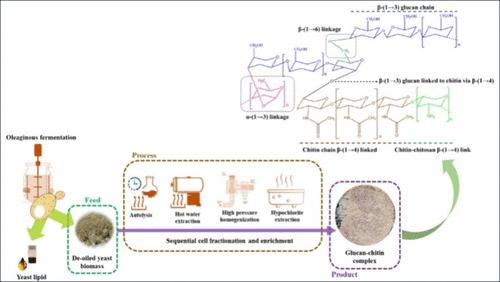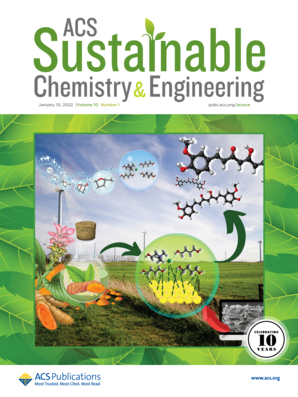Enhanced Glucan–Chitin Complex Extraction from Deoiled Yeast Biomass for Sustainable Biorefinery Applications
IF 7.3
1区 化学
Q1 CHEMISTRY, MULTIDISCIPLINARY
引用次数: 0
Abstract
Spent microbial biomass is a major type of carbon and nitrogen-rich by-product generated by bioprocess industries. These spent biomasses, rich in valuable carbohydrates, has remained underutilized due to a limited understanding of their conversion to value products. One such solid by-product stream is carbohydrate-rich (64.56 wt %) de-oiled yeast biomass, a type of spent microbial biomass originating from the oleaginous fermentation process. The present study deals with the enrichment and extraction of the glucan–chitin complex from DYB focusing on scalability with minimal release of chemical load to the environment. The complex obtained through sequential fractionation and hypochlorite-assisted extraction was assessed for its quality and structural characteristics. A glucan–chitin complex enrichment from 4 to 49.22 wt % glucan with a 17.07 wt % chitin was obtained, exhibiting a helical arrangement of β-(1 → 3) and β-(1 → 6) glucan chains linked to chitin via β-(1 → 4) linkage. The results showed that the investigated process could be integrated with the yeast lipid production chain to obtain these quality compounds from its by-product stream. The green chemistry metrics, viz., PMI, atom economy, and optimum efficiency of 23.34 kg/kg, 1.41, and 8.36, indicated the need for recovery of compounds from the secondary discharge stream of the investigated method to further minimize the carbon and nitrogen loss as a resource.

从脱油酵母生物质中强化提取葡聚糖-甲壳素复合物,实现可持续生物精炼应用
废弃的微生物生物质是生物加工工业产生的一种富含碳和氮的主要副产品。这些废弃的生物质富含有价值的碳水化合物,但由于对其转化为有价值产品的了解有限,因此一直未得到充分利用。富含碳水化合物(64.56 wt %)的脱油酵母生物质就是这样一种固体副产品流,它是油脂发酵过程中产生的一种废弃微生物生物质。本研究涉及从脱油酵母生物质中富集和提取葡聚糖-甲壳素复合物,重点关注其可扩展性和对环境的最小化学负荷释放。通过顺序分馏和次氯酸盐辅助萃取获得的复合物对其质量和结构特征进行了评估。得到的葡聚糖-甲壳素复合物富含 4 至 49.22 wt % 的葡聚糖和 17.07 wt % 的甲壳素,呈现出 β-(1 → 3) 和 β-(1 → 6) 葡聚糖链通过 β-(1 → 4) 链接与甲壳素相连的螺旋排列。结果表明,所研究的工艺可与酵母脂生产链相结合,从其副产品流中获得这些优质化合物。绿色化学指标,即 PMI、原子经济性和最佳效率分别为 23.34 千克/千克、1.41 千克/千克和 8.36 千克/千克,表明有必要从所研究方法的二次排放流中回收化合物,以进一步减少碳和氮资源的损失。
本文章由计算机程序翻译,如有差异,请以英文原文为准。
求助全文
约1分钟内获得全文
求助全文
来源期刊

ACS Sustainable Chemistry & Engineering
CHEMISTRY, MULTIDISCIPLINARY-ENGINEERING, CHEMICAL
CiteScore
13.80
自引率
4.80%
发文量
1470
审稿时长
1.7 months
期刊介绍:
ACS Sustainable Chemistry & Engineering is a prestigious weekly peer-reviewed scientific journal published by the American Chemical Society. Dedicated to advancing the principles of green chemistry and green engineering, it covers a wide array of research topics including green chemistry, green engineering, biomass, alternative energy, and life cycle assessment.
The journal welcomes submissions in various formats, including Letters, Articles, Features, and Perspectives (Reviews), that address the challenges of sustainability in the chemical enterprise and contribute to the advancement of sustainable practices. Join us in shaping the future of sustainable chemistry and engineering.
 求助内容:
求助内容: 应助结果提醒方式:
应助结果提醒方式:


